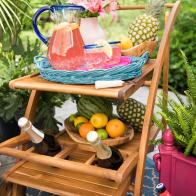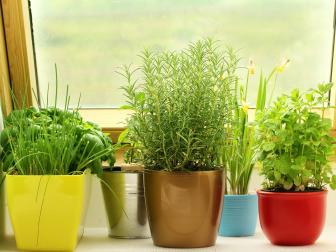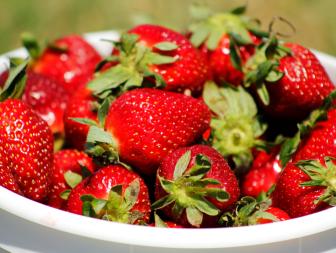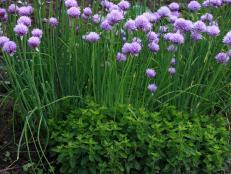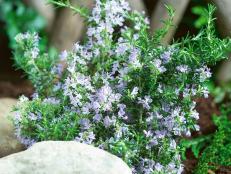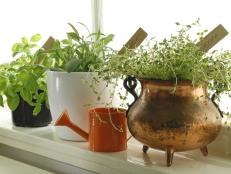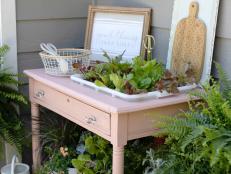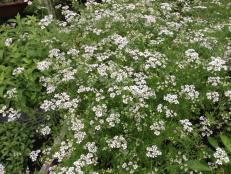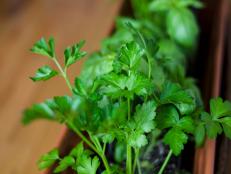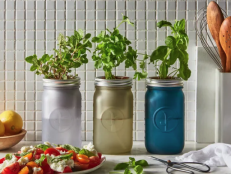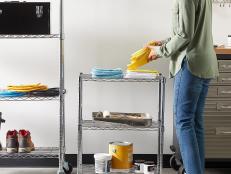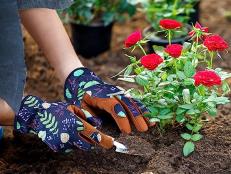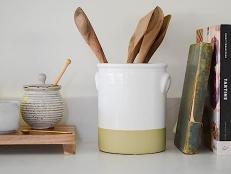How to Plant, Grow and Harvest Lemon Balm
Fragrant, fast-growing lemon balm can be a good addition to garden beds or containers. Learn how to grow this pollinator-friendly perennial.

Lemon balm is a delightful plant to have in a kitchen garden, if for no other reason than to brush a hand over it and release its bright, citrusy fragrance as you walk by. But it has other uses as well, of course. In the kitchen, it can add a bit of lemony zing to salads, main dishes, sides and desserts. The fresh or dried leaves of lemon balm make a soothing cup of hot tea. And in the garden, lemon balm is a friendly (though exuberant) companion to other vegetables and herbs.

Shutterstock/sophiecat
Lemon balm (Melissa officinalis) is a perennial herb in the mint family. The plant is native to the Mediterranean region and central Asia, but is now grown in temperate regions around the world and offers a variety of benefits in the garden.
Lemon balm (Melissa officinalis) is a perennial herb in the mint family. Its textured leaves have serrated edges, and it grows and spreads into a mound 2 to 3 feet tall. When it blooms, in mid to late summer, it opens small white flowers that attract bees and other insects. The plant is native to the Mediterranean region and central Asia but is now grown in temperate regions around the world.
The most familiar version sold in nurseries and garden centers is light to medium green in color. Less-common varieties include ‘Aurea,’ with golden-yellow spots on the leaves and cream-colored blooms; ‘Variegata,’ a variegated lemon balm; and ‘Quedlinburger,’ which has the most intense lemon fragrance.
Like other mints, it grows quickly and abundantly in the right conditions: fertile, well-drained soil in full sun or part shade. Gardeners who grow lemon balm can enjoy the advantages and quickly learn the need to keep an eye on it in the garden.

Shutterstock / Manfred Ruckszio
Plant nursery starts or pass-along cuttings of lemon balm in a sunny or semi-shady location.
How to Plant Lemon Balm
You can easily add lemon balm to your garden by growing it from seeds or from nursery-grown plants.
The easiest way is to buy starts from a nursery or garden center or receive pass-along root cuttings from gardening friends. Plant them after the danger of frost is past. Plant in good soil in a sunny or semi-shady location. Lemon balm grows quickly, so give it a place in the garden where it has room to spread.
To grow from seeds, sow seeds outdoors in prepared soil after the last frost date in your area. Press a group of three or four seeds into the soil, spacing groups of seeds about 18 inches apart. Sprouts emerge in about two weeks; when the seedlings are about an inch tall, thin to one seedling from each group.
Lemon balm seeds can be started indoors six to eight weeks before the average last frost date and transplanted into the garden when the temperature is reliably warm.
This herb also grows happily in a pot outdoors, or even indoors. To keep a pot of lemon balm happy in the house, locate it near a window where it can receive about six hours of sunlight, or place it under grow lights. Water the soil when it feels dry.
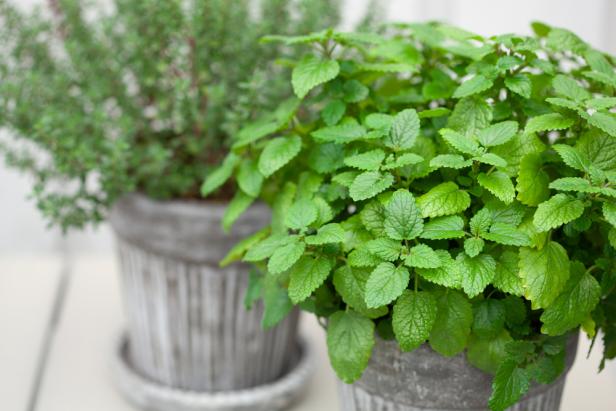
Shutterstock/Olga Miltsova
Lemon balm can be grown in a container outdoors or indoors. To grow indoors, locate it near a window where it can receive about six hours of sunlight, or place it under grow lights. Water the soil when it feels dry.
How to Care for Lemon Balm
Lemon balm grows best with regular watering, though it will tolerate some dry spells. If it’s growing in good soil, it doesn’t need fertilizer. As an herbaceous perennial, it dies back to the ground in winter and re-emerges in spring.
Lemon balm is an easy herb to propagate or to share with gardening friends. It grows easily from tip and root cuttings.
How to Harvest + Preserve Lemon Balm
You can pinch or snip lemon balm leaves as you need them for cooking or a cup of tea. When you’re ready for a larger harvest, or to prune to control its growth, use pruners to cut the stems to the desired length above a leaf node. You can shear a large clump of lemon balm by half; pruning the plant stimulates new growth.
To air-dry lemon balm, clip long stems, bundle four or five stems together at the base and tie them with string and hang them in a warm, dry place. The leaves and stem should dry in two to three weeks. Store the dried leaves in glass jars or other airtight containers. You can also strip the leaves from the stem and dry them on a tray or screen in a warm, shady location.
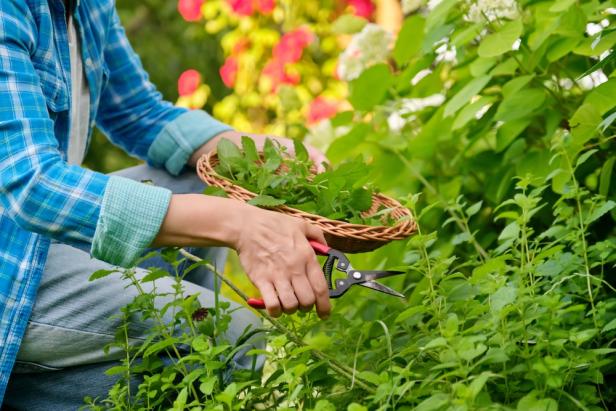
Shutterstock/VH-studio
Snip or pinch lemon balm leaves as you need them for cooking or a cup of tea. When you’re ready for a larger harvest, or to prune to control its growth, use pruners to cut the stems to desired length above a leaf node.
Problems With Growing Lemon Balm
Lemon balm is generally resistant to pests and diseases. Gardeners may report powdery mildew or root rot from too much moisture, especially if it is growing in a container.
A more persistent problem may be its tendency toward weediness. Lemon balm is in the mint family, and while it’s not as aggressive as other mint species, it spreads rapidly if flowers are allowed to go to seed. Gardeners who grow and harvest lemon balm suggest harvesting it often to avoid flowering — even cutting it back two or three times during the growing season.
If, over time, you find that it has become more of a weed than an asset, the best way to eliminate it is by removing the roots — every bit of them. Roots left in the ground will continue to grow and send up more lemon balm, so if you really want to get rid of it, diligence is key.
Companion Planting With Lemon Balm
Lemon balm grows safely and happily alongside anything that shares the same growing conditions — rich soil that drains well, and full sun or part shade. The herb is said to repel many insects, including squash bugs, so it would be an especially good companion alongside vegetables in the squash and cucumber family. Deer and rabbits don’t like it, so if it’s strategically placed, it might work as a deterrent to those garden visitors.
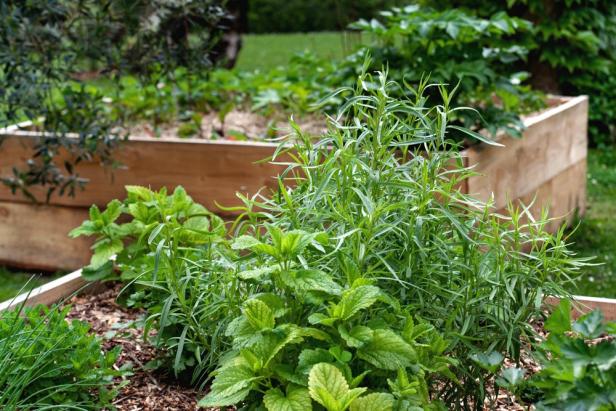
Shutterstock/redzen2
Lemon balm grows safely and happily alongside anything that shares the same growing conditions – rich soil that drains well, and full sun or part shade.
Just keep in mind its tendency to spread, and keep it in check by removing the flowers before they form seeds.
A–Z Advice for Companion Planting in Your Vegetable Garden 16 Photos
Find detailed info and links for specific companion plants and planting techniques for popular vegetable garden crops in our alphabetical list, from beets to zucchini.
How to Use Lemon Balm
Some ideas gathered from a variety of sources include:
Relaxing hot tea: Crush a handful of fresh or dried lemon balm leaves into a cup, add boiling water and steep for about five minutes. For iced tea, toss a generous handful of fresh leaves into a saucepan, add water and bring it to a boil. Remove from heat and strain the water into a pitcher, sweeten as desired, chill, and serve over ice.
Ingredient in pesto: Toss a handful of lemon balm leaves into the mix with other ingredients to add a light lemon flavor.
Flavored oils: Add oil to a handful of crushed leaves in a clean glass jar, close the jar and allow it to steep for several days, then strain the oil and return it to a clean jar.
Quick, natural insect repellent: Crush a few leaves and rub them on your skin. Compounds in lemon balm, including citronella, may keep the mosquitoes from biting.
Ingredient in potpourris: Mix dried lemon balm leaves with other fragrant dried botanicals: rose petals, lavender flowers and leaves, calendula, citrus peel, spearmint — experiment!
Medicinal uses, with caveats: Lemon balm is considered a calming herb, and as a supplement combined with other herbs is said to treat a variety of ailments. The use of lemon balm has not been approved by the US Food and Drug Administration, however, and researchers note that its use may interact adversely with thyroid, glaucoma and other medications. Individuals with these conditions should talk to their healthcare provider before using lemon balm.

Shutterstock/GreenArt
Crush a handful of fresh or dried lemon balm leaves into a cup, add boiling water and steep for about five minutes to make a relaxing cup of lemon balm tea.
How to Plant a Kitchen Herb Garden
Herbs are easy to grow, they don’t take up a lot of space and they are a healthy way to add more flavor to your cooking. Whether you’re a beginning gardener or looking to elevate your culinary skills, an herb garden is the way to go.
Can You Freeze It? 35 Photos
Find out how to freeze fruits and vegetables such as bananas, watermelon, apples and avocados as well as some surprising things you maybe didn't know you could freeze like eggs and milk.

%20Taniya%20Nayak,%20Ty%20Pennington,%20Alison%20Victoria,%20and%20Brian%20and%20Sarah%20Baeumler_BOTB_HGTV%20.jpg.rend.hgtvcom.196.196.suffix/1683310636672.jpeg)


